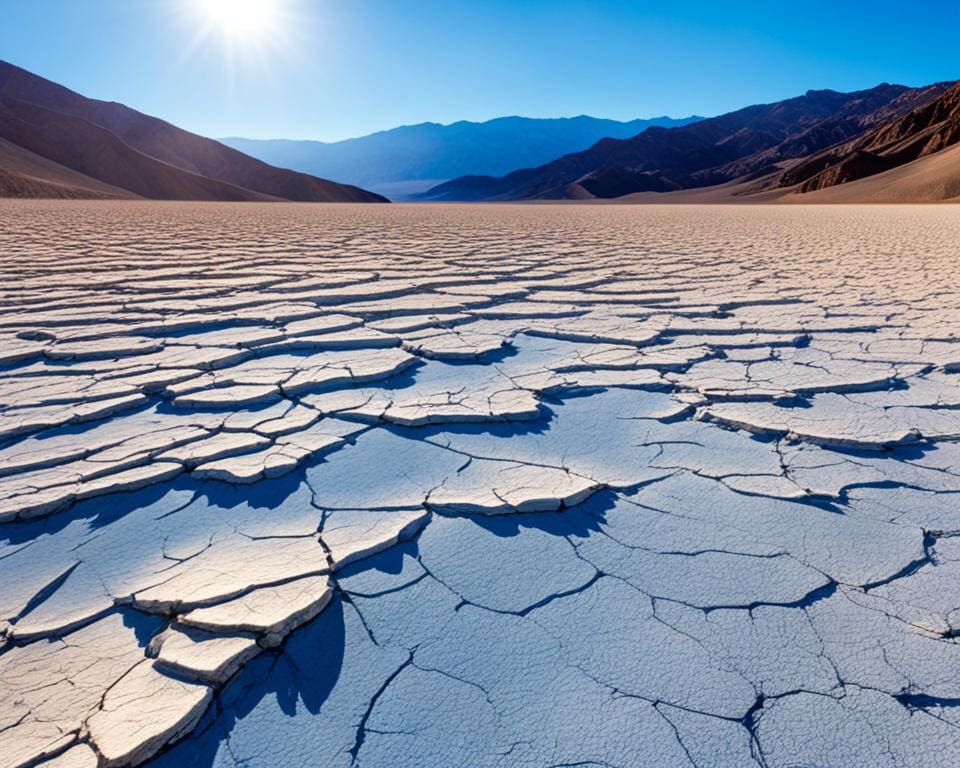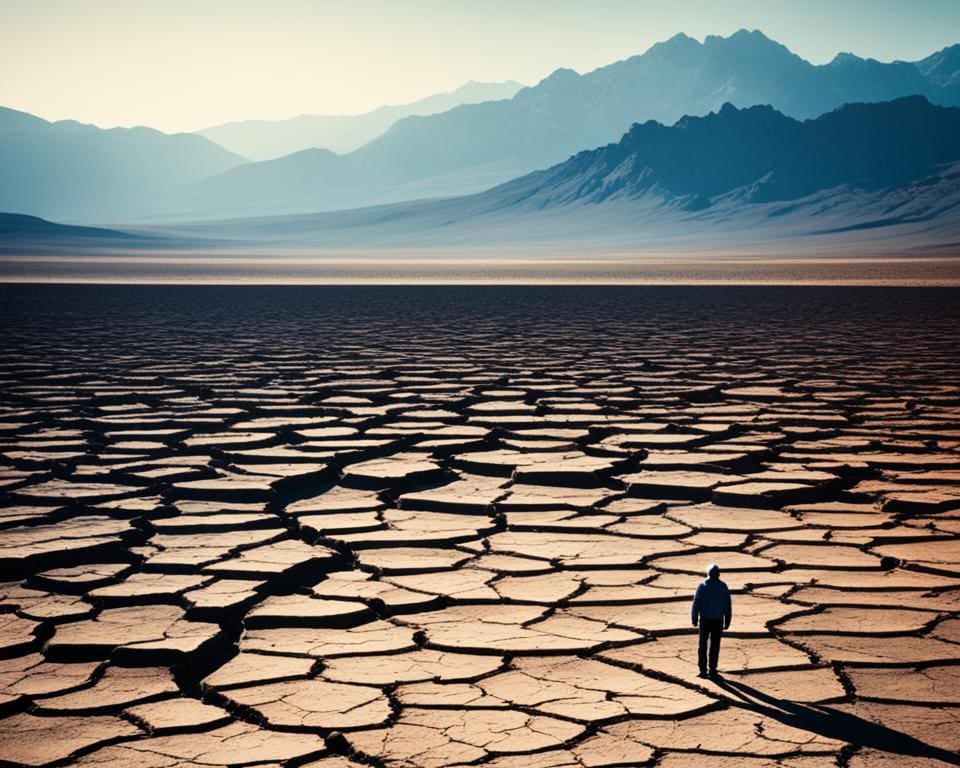Death Valley is famous for its intense heat. It draws around 300,000 visitors each summer, including folks from abroad. With temperatures often hitting 120 degrees Fahrenheit in August, it’s the hottest spot in North America. The last ten years have seen some of the hottest summers here. Climate change is making things worse, leading to record-breaking temperatures and more than 2,300 heat-related deaths last year.
Temperatures in the park have reached a scorching 134 degrees Fahrenheit. This is a record that Death Valley still holds. For those visiting Death Valley National Park, knowing how to stay safe in extreme heat is key. The stunning views come with dangerous heat, making it essential to be well-prepared for this challenging adventure.
The Extreme Climate of Death Valley
Death Valley is known as the hottest place in North America. It often sees summer temperatures soar above 120 degrees Fahrenheit. Its location below sea level and surrounded by mountains explains the sweltering heat.
Understanding Death Valley Weather Conditions
Death Valley is a unique desert, receiving less than 2 inches of rainfall yearly. The heat and low humidity make it tough for life to thrive. However, natural springs are crucial for survival, despite the ongoing threats of drought.
When it gets extremely hot, temperatures can reach up to 126 degrees Fahrenheit. This is close to the highest temperatures ever recorded here.
Impact of Climate Change on Heat Levels
Climate change is making survival harder in Death Valley. For example, in 2020, there were 169 days with temperatures over 100 degrees. The Devils Hole pupfish, already critically endangered, struggles more as temperatures climb.
A third of the bird species in the area have dropped in numbers due to heat stress. Even the ancient bristlecone pines are dying off faster, showing the wide impact of rising temperatures.
Record Temperatures: Historical Context
Since the early 1900s, Death Valley has seen some record-breaking temperatures. In 2021, temperatures exceeded 125 degrees on 11 days. Advances in technology have improved how we measure these extreme temperatures. Such accurate data help us understand the effects of climate change better.

Death Valley: Surviving the Hottest Place in the U.S.
Planning a trip to Death Valley? It’s key to know how to stay safe in extreme heat. This harsh desert requires you to be prepared. It’s vital to learn how to survive in these conditions.
Key Survival Tips for Visitors
To handle this tough environment, keep these tips in mind:
- Hydrate frequently: Always have plenty of water on hand. It’s crucial to drink a lot in temperatures that often exceed 120 degrees Fahrenheit.
- Limit outdoor activities: Do hard tasks in the early morning or late evening. This helps avoid the peak heat of the day.
- Prepare your vehicle: Make sure your car is ready and reliable. This is key to avoid getting stranded.
- Seek shade: Use natural spots or bring your own shade. This will help you avoid the harsh sun.
- Wear protective clothing: Wear clothes that are loose and light in color. And don’t forget high-SPF sunscreen.
Staying Safe in Extreme Heat: Precautionary Measures
Staying safe in the heat is a top priority. Remember these steps:
- Know emergency services: Be aware of where to find help. This is crucial if things go wrong.
- Monitor symptoms: Be alert to how you feel. Symptoms like dizziness and confusion can signal heat-related illnesses.
- Travel in groups: It’s safer and more fun to explore with others. They can help if you need it.
- Educate yourself: Know the unique geography of Death Valley. It’s the driest place in North America.
By following these guidelines, you can safely enjoy Death Valley. It’s about making your visit a positive adventure, not a dangerous one.
Flora and Fauna Adaptations to Extreme Heat
Death Valley is a place where life flourishes under harsh conditions. The area is known for its extreme heat, with temperatures over 120 degrees Fahrenheit. Despite this, the local wildlife and plants have evolved unique ways to survive.
Wildlife Survival Strategies in Death Valley
In Death Valley, animals display incredible toughness against the heat. For example, bighorn sheep can go days without water, losing up to a third of their weight. Kangaroo rats have an amazing ability to live without ever drinking water directly; they get what they need from their food. Desert tortoises spend most of their time underground, coming out only for a few months each year.
This shows how different creatures have adapted to such a dry place. Animals like jackrabbits cool off by releasing heat through their large ears. Many are active at night, avoiding the sun’s heat. Pupfish can handle water temperatures over 112 degrees Fahrenheit and live in very salty conditions.
Unique Plant Adaptations to Arid Conditions
Death Valley’s plants also have special ways to cope with the dryness. They have shallow roots to grab as much moisture as they can. These plants also reduce water loss with thick leaves and waxy coatings.
Understanding these adaptations helps us see the delicate balance of life in Death Valley. The plant and animal survival strategies here are truly inspiring. They thrive where most would not survive. These adaptations offer lessons on resilience in the toughest environments.
Exploring Safety Practices in Death Valley National Park
Death Valley National Park is a place with harsh terrain, where visitor safety is key. It’s vital to follow park rules. These rules help people stay safe by using marked paths and air-conditioned cars. Death Valley is one of the hottest spots on Earth. Temperatures can reach 130 degrees Fahrenheit. So, taking steps to stay cool is a must. Rangers help by giving out the latest weather news and teaching about the dangers of extreme heat. They remind everyone to drink at least one gallon of water daily to make up for lost fluids.
When you’re in this huge desert, watch out for dangers. More people die in Death Valley from car crashes than anything else. This shows the importance of careful driving. Also, don’t rely on your cell phone or GPS here. They might not work well, which can lead to getting lost. Keeping to the known roads is a smart way to avoid trouble. This way, your visit to the park will be fun and safe.
Always be on the lookout for wildlife and sudden weather changes. Hantavirus, a serious illness, hasn’t been seen in Death Valley. Yet, it’s wise to be careful where there are lots of rodents. Also, sudden windstorms can cause whiteouts. This makes it hard to see and can be dangerous. By putting safety first in Death Valley National Park, you can enjoy its stunning scenery safely. Remember, the park is beautiful but has risks.









